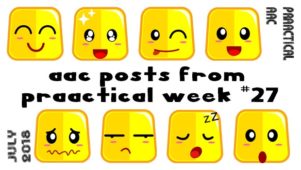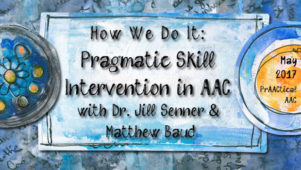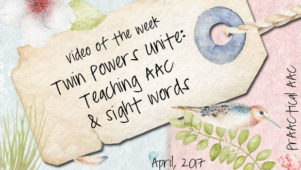5 Little Things that Make a Big Difference in AAC Intervention

“If you think you are too small to be effective, you have never been in bed with a mosquito.” Betty Reese
–
Little things can make or break a good streak of AAC implementation. Here are some things that we’ve come to appreciate. They’re small in size, expense, or time demands but pay off in a big way.
–
1. Wait time: There’s nothing like a 10-second expectant pause and controlled access to help someone learn to respond without more intrusive prompts.
–
2. Clear plastic jars with screw-on lids (nothing beats these for limiting access so that kids are tempted to make a request)
–
3. Button covers for the iPad, like these from BubCap. Amazing how a tiny piece of plastic can keep an activity or conversation from derailing.
–
4. Bragging (authentically) about a colleague. “Ms. Mama, I have to tell you how awesome Polly Para was today. She had Suzie’s AAC system all set up and ready to go before Tara Teacher even started the lesson. Suzie was the first one to volunteer an answer.” We all like to be recognized for our efforts, and tying it to positive outcomes for the kids doubles the power of a compliment.
–
5. Sabotage: A little creativity in planting obstacles can go a long way in creating an authentic context for someone to use their AAC skills. There’s nothing like a foot discretely wedged against a door to help the clinician elicit ‘open it’ or giving a single puzzle piece to elicit ‘more.’ Sabotage + expectant pause = A clear message to the learner that it’s his/her turn to do or say something.
–
What little things are you using and appreciating this week?
–
Filed under: PrAACtical Thinking
Tagged With: intervention
This post was written by Carole Zangari





2 Comments
I am loving the power of peer participation and “practicing what you preach” (so to speak)! When I talk to my kids with AAC, and more importantly, when their friends talk to them with AAC, the conversation is beautiful 🙂
We couldn’t agree more, Tanna. It is a win-win situation. With the right supports, the typically developing kids love when the barriers to friendship come down just as much as their AAC-using classmates do. And it is one of the few situations in which our kids get to outshine their peers: they’re becoming the experts with the AAC system and it sure intrigues their friends. A lot of the fun apps that you feature on your site are so perfect for teaching language in that collaborative way. Everyone wins.